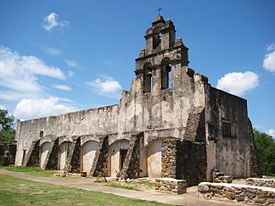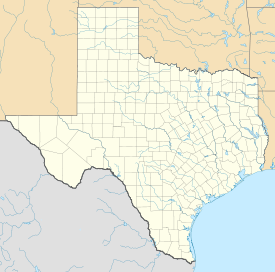- Mission San Juan Capistrano (Texas)
-
- Another mission bearing the name San Juan Capistrano is the Mission San Juan Capistrano in San Juan Capistrano, California.
Mission San Juan Capistrano
La Misión de San Juan CapistranoThe chapel of Mission San Juan Capistrano and its integral campanario, or "bell wall." The buttressess were added in later years to provide support.
Basic information Location San Antonio, Texas
 USA
USAGeographic coordinates 29°19′58″N 98°27′19″W / 29.332687°N 98.4552889°WCoordinates: 29°19′58″N 98°27′19″W / 29.332687°N 98.4552889°W Affiliation Roman Catholic Architectural description Architectural style Spanish Completed Founded 1731 Specifications U.S. National Register of Historic Places Added to NRHP: February 23, 1972 NRHP Reference#: 72001352 Mission San Juan Capistrano (originally christened in 1716 as La Misión San José de los Nazonis and located in East Texas) was founded in 1731 by Spanish Catholics of the Franciscan Order, on the eastern banks of the San Antonio River in present-day Bexar County, Texas. The new settlement (part of a chain of Spanish missions) was named for a 15th-century theologian and "warrior priest" who resided in the Abruzzo region of Italy. The mission San Juan was named after Saint John of Capestrano.
Contents
Mission
The first primitive capilla (chapel) was built out of brush and mud. Eventually a campanile, or "bell tower" containing two bells was incorporated into the structure, which was replaced by a long hall with a flat roof and an attractive belfry around 1756. Around 1760 construction of a larger church building was begun on the east side of the Mission compound, but was never completed due to the lack of sufficient labor. Mission San Juan did not prosper to the same extent as the other San Antonio missions because lands allotted to it were not sufficient to plant vast quantities of crops, or breed large numbers of horses and cattle; a dam was constructed in order to supply water to the Mission's acequia, or irrigation system. (the Mission reportedly owned 1,000 head of cattle, 3,500 sheep and goats, and 100 horses in 1762).
Some 265 neophytes resided in adobe huts at the Mission in 1756; by 1790 the native Coahuiltecan people were living in stone quarters, though their number had dropped to 58. San Juan Capistrano was administered by the College of Santa Cruz de Querétaro until March of 1773, when it was placed under the care of the College of Nuestra Señora de Guadalupe de Zacatecas.
Secularization
The Mission was secularized on July 14, 1794, after which time it was attended by the resident priest at Mission San Francisco de la Espada, until about 1813; it was then attended by the one remaining missionary at the nearby Mission San José y San Miguel de Aguayo until 1824. Mission San Juan was largely neglected until 1840, when religious services were once again conducted, this time by diocesan priests. Members of the Claretian and Redemptorist Orders also held mass in the church until 1967, when the Franciscans returned to Mission San Juan.
Theft of Three Altar Statues
Three Spanish Colonial-period statues that sat at the altar were stolen sometime on the night of Monday, July 31 or early the morning of Tuesday, August 1, 2000. The statues are between 3–4 feet tall and are constructed of carved wood that had been painted. They are considered priceless due to their religious and historical significance.
San Antonio Missions National Historical Park
As part of a public works project in 1934 some of the native quarters and the foundations of the unfinished church were unearthed. The chapel, priests' quarters, and other structures were reconstructed during the 1960s. Most of the original square remains within the courtyard walls, portraying an authentic depiction of the floor plan and layout. Mission San Juan has been maintained by the National Park Service as a part of the San Antonio Missions National Historical Park since the 1980s.This mission was considered the mother of all missions.
Gallery
-
Tierra Sagrada Mission .JPG
Tierra Sagrada "Sacred Earth" is an unfinished church from 1780, where indigenous people who built the mission were buried.
See also
- Spanish missions in Texas
- Mission Nuestra Señora de la Purísima Concepción de Acuña - also called Mission Concepcion
- Mission San José y San Miguel de Aguayo - also called Mission San José
- Mission San Francisco de la Espada - also called Mission San Espada
- Espada Acequia
External links
Spanish missions Asia (Jesuit) · Arizona · Baja California · California · Carolinas · Florida · Georgia · Louisiana · Mexico · New Mexico · Sonoran Desert · South America · South America (Jesuit) · Texas · Trinidad · Virginia
Early Texas Settlements Spanish Missions in Texas Mission San Francisco de la Espada · Mission San Juan Capistrano (Texas) · Mission Concepción · Alamo Mission in San Antonio · Mission San José (Texas) · Mission Nuestra Señora del Espíritu Santo de Zúñiga · Mission Santa Cruz de San SabáSpanish Forts of Texas Armed conflicts Empresarios See also Categories:- Spanish missions in Texas
- 1731 establishments
- Archaeological sites in Texas
- History of San Antonio, Texas
- Buildings of religious function on the National Register of Historic Places in Texas
- Buildings and structures in San Antonio, Texas
- Spanish Colonial architecture in Texas
- Visitor attractions in San Antonio, Texas
Wikimedia Foundation. 2010.




